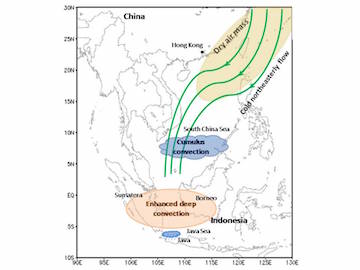Common Remarks
The southward movement of cold air outbreaks from the Siberian-Mongolian High (SMH) are an important aspect of the intraseasonal variability of the winter monsoon. This cold and dry intrusion - often called "cold surge" - is associated with a rise in surface pressure, a sharp drop in temperature in China and a strengthening of northerly winds extending as far south as the equator.
 |
As the surge moves southward, it often interacts with convection processes over the South China Sea, in the region north of Borneo, along the Indo-China coast and Java Sea. The severe weather accompanying the intense cold surge often brings about major disruptions of agricultural and economic activities in the affected regions.
I. Appearance in Satellite Data
Learn about how to recognise and detect Northerly Cold Surge in satellite images.
II. Meteorological Physical Background
Find out more about the meteorlogical and physical background of Northerly Cold Surge
III. Key Parameters
Learn which key parameters to use for montoring Northerly Cold Surge
IV. Typical Appearance In Vertical Cross Sections
Find out the typical appearance of Arctic Northerly Cold Surge in vertical cross section
V. Weather Events
Explore the weather events associated with Northerly Cold Surge
VI. References
Let these comprehensive documents in the references assist you in finding more about Northerly Cold Surge